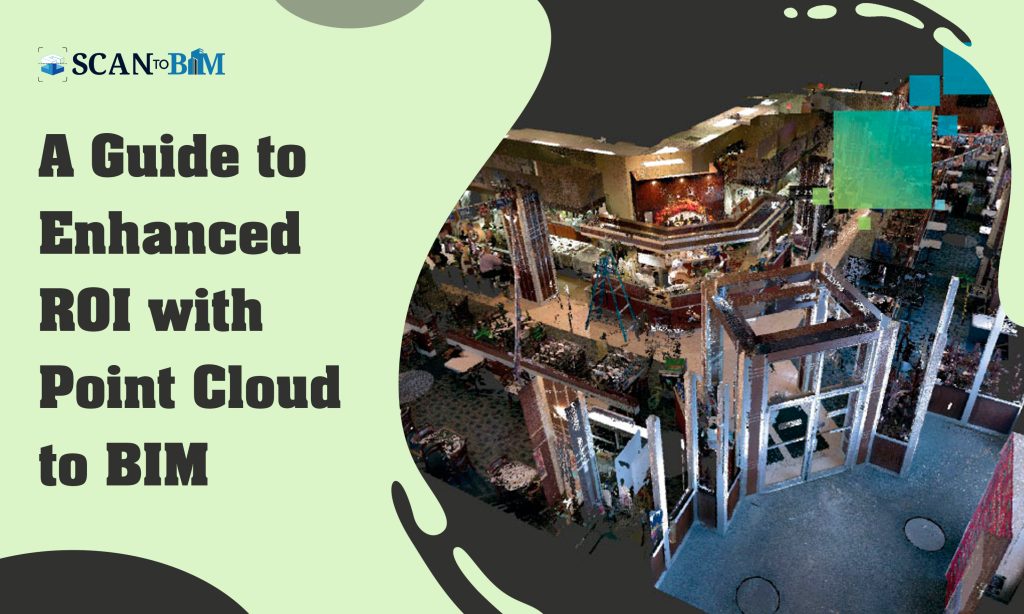
Introduction:
In the dynamic world of construction and design, staying ahead of the curve is not just an aspiration; it’s a necessity. The integration of cutting-edge technologies has become a pivotal factor in achieving efficiency, accuracy, and ultimately, a maximized return on investment (ROI). One such transformative technology that has revolutionized the construction landscape is Point Cloud to BIM. In this blog, we will dive deep into the significance of Point Cloud to BIM Services and how it serves as a catalyst for maximizing ROI in construction projects.
Understanding Point Cloud to BIM:
Before we explore how Point Cloud to BIM can enhance ROI, let’s briefly understand these two integral components.
Point Cloud:
Point Cloud is a collection of data points in a three-dimensional coordinate system. These points represent the external surface of an object or the entire scene. This technology is commonly used in reality capture processes, such as laser scanning or photogrammetry, to create a highly accurate and detailed representation of existing structures or environments.
Building Information Modelling (BIM):
BIM is a digital representation of the physical and functional characteristics of a building or infrastructure. It goes beyond traditional 3D modelling by incorporating additional dimensions such as time (4D) and cost (5D). BIM allows stakeholders to collaborate seamlessly throughout the entire lifecycle of a project, from conceptualization to maintenance.
Maximizing ROI with Point Cloud to BIM:
1) Precision in As-Built Documentation: One of the primary advantages of using Scan to BIM is the unparalleled precision it offers in capturing existing structures. Traditional as-built documentation methods often fall short in accuracy and can lead to costly errors during the design and construction phases. Point Cloud technology ensures that the BIM model is an exact representation of the real-world environment, minimizing discrepancies and reducing the likelihood of rework.
2) Streamlining Design and Construction Processes: The integration of Point Cloud data into BIM facilitates a seamless transition from design to construction. Designers and architects can work with a detailed and accurate representation of the existing site, making informed decisions and minimizing design clashes. This streamlining of processes not only accelerates project timelines but also reduces the likelihood of costly revisions and delays.
3) Clash Detection and Resolution: Clash detection is a critical aspect of construction project management. By combining Point Cloud data with BIM, clashes can be identified and addressed at the pre-construction stage. This proactive approach not only saves time but also prevents costly rework and modifications during construction. The result is a smoother construction process with minimized disruptions and increased overall efficiency.
4) Optimizing Resource Allocation: Efficient resource allocation is key to maximizing ROI in construction projects. Point Cloud to BIM enables stakeholders to analyze and optimize resource allocation based on the accurate representation of the existing site. This includes assessing material quantities, labor requirements, and equipment placement. By optimizing resource allocation, projects can be executed with greater precision and cost-effectiveness.
5) Accurate Cost Estimation and Budget Control: The 5D capabilities of BIM, when coupled with Point Cloud data, empower project managers with accurate cost estimation tools. This level of detail allows for a comprehensive understanding of project costs, from materials and labour to equipment and scheduling. With precise cost estimates, project budgets can be controlled more effectively, minimizing the risk of budget overruns and enhancing overall project financial health.
6) Enhanced Collaboration and Communication: Collaboration is a cornerstone of successful construction projects. Point Cloud to BIM facilitates enhanced collaboration among stakeholders by providing a common platform for sharing accurate and up-to-date information. Architects, engineers, contractors, and other team members can collaborate in real time, reducing communication gaps and ensuring everyone is on the same page throughout the project lifecycle.
7) Facilitating Facility Management: The benefits of Point Cloud to BIM extend beyond the construction phase. The detailed and accurate BIM model, enriched by Point Cloud data, serves as a valuable asset for facility management. From routine maintenance to future renovations, facility managers can leverage the BIM model to make informed decisions, leading to further long-term cost savings.
Conclusion:
In the ever-evolving landscape of construction and design, embracing innovative technologies is not just a choice; it’s a strategic imperative. Point Cloud Modelling has emerged as a transformative force, revolutionizing how projects are conceptualized, designed, and executed. By maximizing precision, streamlining processes, optimizing resource allocation, and enhancing collaboration, Point Cloud to BIM becomes a catalyst for achieving the holy grail of construction—maximizing ROI. As the industry continues to evolve, those who harness the power of Point Cloud to BIM will undoubtedly find themselves at the forefront of efficiency, accuracy, and ultimately, success.